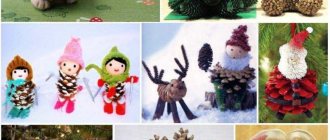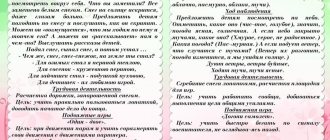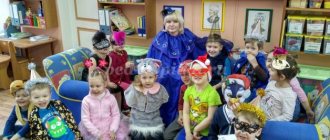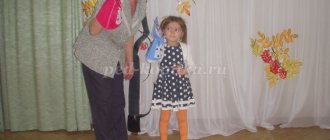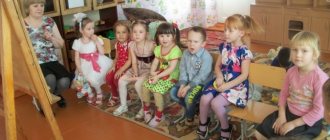Lesson summary for the middle group “Living and inanimate nature”
Doll: Air? And who saw it, this air? Maybe he doesn’t exist at all? Personally, I have never seen air! What about you guys?
Educator: Tell me, guys, do you see the air around us?
Children: No, we don’t see it.
Educator: Since we don’t see it, what kind of air is it?
Children: The air is transparent, colorless, invisible.
Doll: That's it! Invisible! That means he doesn’t exist at all!
Educator: Wait, wait, Doll! I haven’t seen the air either, but I know that it is always around us!
Doll: Oh, you know everything! But I don’t believe you! Now prove that this very air exists!
Educator: Guys, let's prove to the Doll that there is still air! To see air, you need to catch it. Do you want me to teach you how to catch air?
Children: Yes.
Experiment 1. With a plastic bag
Educator: Take a plastic bag. What's in it?
Children: It's empty.
Educator: It can be folded several times. Look how thin he is. Now we fill the bag with air and twist it. The bag is full of air, it looks like a pillow. The air took up all the space in the bag. Now let's untie the bag and let the air out of it. The package became thin again. Why?
Children: There is no air in it.
Educator: Look, Doll! Conclusion: the air is transparent, to see it, you need to catch it. And we were able to do it! We caught the air and locked it in a bag, and then released it.
Doll: This bag reminded me of something! In the summer I saw how people use such “locked” air! On the sea! It looked like it was an air mattress! I also saw children wearing lifeguards and even a lifebuoy!
Doll: I wonder if there is air inside people?
Educator: What do you think, guys? Let's check?
Experiment 3. Air in a person.
Blow into a tube placed in a glass of water.
Educator: Blow into a tube placed in a glass of water. What's happening?
Children: Bubbles come out.
Educator: You see! Conclusion: this means there is air inside us. We blow into the tube and he comes out. But in order to blow more, we first inhale new air, and then exhale through the tube and we get bubbles.
Doll: I see. You exhale. It means it is inside you. But how does it get to you? Through the nose?
Educator: Of course! All people breathe through their nose. Guys, let's show how our noses breathe.
Educator: Guys, we got distracted, but we need to finish the picture for Tube, listen to the following riddle:
They purify the air, create comfort, turn green on the windows, and bloom all year round. Answer: (Flowers)
A red, small lump, There are a few dots on its back, It doesn’t scream or sing, But it crawls along a leaf.
(Ladybug.)
Small, remote,
Passed through the earth
Summary of a lesson in kindergarten in the middle group on the topic: “Nature in human life”
Lesson in the middle group on the topic: “Nature in human life”
Goal: to develop knowledge about the importance of nature in human life Objectives: Educational:
1. To form an idea of the inextricable connection between man and nature;
2. expand children’s knowledge about the role of the sun, air and water in human life, as well as their properties. Developmental:
1. Develop in children the ability to analyze and self-control their behavior in nature 2. Form interest in experimental work.
Educational:
1. Foster a caring attitude towards the environment;
2. create cognitive interest; 3. the ability to see the beauty of nature, to show an emotional attitude towards it. Equipment: “Magic Glade” program - a set of interactive educational and educational games for children;
ready-made images with a crocodile, the sun and rays on magnets, clouds; excerpt from the animated film “Stolen Sun”, paper fans; transparent cups, jug; cocktail straws, plastic bags, backpack, first aid kit, bandage, water, soap bubbles, pine twigs, music. Progress of the lesson:
The teacher and children are located in a circle
- I’m glad to see you so beautiful, kind, and in a good mood.
May this day bring you joy and many new interesting experiences. And where and how we will spend this day - you will find out if you guess the riddle: He undresses in winter, dresses in spring, and gives berries and mushrooms in summer. (forest) - That's right, guys, today we will go on a hike into the forest. - Tell me, what should we take with us to the forest? What equipment should tourists have? (backpack, salt, water, compass...) - What if we get hurt? (first aid kit) - Let's remember how to behave during our hike? What can't you do in the forest? (scream loudly, make fires, go far from each other) - we have collected everything you need, and now you can safely walk. (we take a backpack with us, walk with the children towards the screen, suddenly alarming music sounds) - Oh, guys, something happened. They probably need our help. Let's see what happened in the forest. Sit down in the clearing. (children sit down on the carpet) Watching an excerpt from the cartoon Stolen Sun - Guys, do you remember the name of the cartoon? - What happened to the animals when the crocodile swallowed the red sun? - Can people, animals, birds, plants, animals live without the sun? - What will happen to us? Game “Collect the sun” At the magnetic board
- Guys, the animals are asking us to save the sun and return it to the sky.
(sun in the teeth of a crocodile) - And for this we need to collect the rays that our sun lost. Let's help it shine so brightly that the crocodile cannot withstand its heat and releases the sun into the sky. Children line up in a column and stick on alternating long and short rays. Conversation about the wind - Guys, while we were saving the sun, clouds appeared in the sky and covered our sun, and it became sad. - Tell me, please, which friend will help us disperse the clouds? - Where can we get it? - What is this? (I show the children the fan.) Do you understand why we need it? - So let's create a breeze ourselves to drive away the clouds. To do this, let’s wave our fan at ourselves, at our friend. Did you feel the breeze? Wind is the air that we set in motion. (removing the clouds) Experiments with air - Please tell me, why do we need air? -Can we live without air? - Let's conduct an experiment. Cover your nose with one hand and close your mouth well and tightly. Neither nose nor mouth should be opened. - Why did you open it? What happened? How did you feel? - Let's smell the air. Does it smell? - He only tolerates other smells. Any taste? -Can we see air? What is he like? - Do you know how you can see the air? “How to see the air” (children approach the table with glasses)
- Take a cocktail straw, lower one end into a glass of water, and take the other end into your mouth.
We, like fish, will release air bubbles in the water. — What comes out of the water with bubbles? -What other bubbles can you blow? (soap bubbles) - What is inside soap bubbles? (air) “How to catch air?” “We saw the air, and now let’s catch it.” — Take the plastic bags from the table and try to catch the air. - Tighten the bags. What happened to the packages? What's in them? What is he like? Do you see him? — Bring it to your face and press it with your hands. What do you feel? — Air is everywhere. Air is needed to live and breathe. Relaxation “In a forest clearing” Children sit down on the carpet.
Sounds of nature, birdsong - Guys, we've been walking for so long that our legs are tired.
Let's sit down in a forest clearing. - Let's all close our eyes and rest. The sun is shining. Its rays caress our cheeks, nose, arms, legs. We hear a light breeze. And we feel so good. We open our eyes. Where is water in the forest? I look into my backpack, and there is an empty bottle.
There is water at the bottom. — There is very little clean water left in the bottle.
What to do? Can we survive without water? - Tell me, where can we find water in the forest? (the sound of a spring can be heard)
- Oh, do you hear what that sound is?
- This is a spring not far from us. Let's find him. The teacher and children get up and go to the spring Experiments with water Spring (a container of water that resembles a spring), needles and leaves float on top. The teacher draws water into a transparent jug - Look, guys, what floats in the water? -That’s right, the fontanel also travels through the forest and its water becomes dirty. Guys, we need to fill the bottle with water. — How to make water clean? (clean it) - There are different cleaning filters. And we ourselves will make the simplest filter from gauze and clear the water of large debris. They clean the water with gauze, pour it through a funnel into a bottle - We have purified the water. Now tell me - can you see the bottom of the bottle? So what kind of water is it? -What color is it? - Let's smell it, does it smell? No. This means it has no smell. - Let's try it. Any taste? No. When can she change her taste? (sugar, salt) Screen block “Psychological relief” - various effects
- Guys, do you know who else cannot live without water?
The teacher draws attention to the screen - Let's go to our magic screen and find out who else cannot live without water. - Come on, you and I will play with some water and touch it. Lesson summary : Water is life. Everyone needs it: humans, animals, and plants. - What else can’t we live without? And we also cannot live without air, and without the sun. Tell me, is the sun, water, air - living or inanimate nature? Remember, guys, the sun, air and water are our best friends! Game “Soap Bubbles” - Let’s blow airy, wind-obedient, soap bubbles in a forest clearing. So that our trip will be remembered by us for a very, very long time. Happy music sounds
We recommend watching:
Summary of educational activities for children with parents in the middle group. Do-it-yourself doll Summary of a lesson on speech development on the topic “Toys” in the middle group Methodological development of GCD for the development of communicative activities in children of the middle group Synopsis of a game lesson in mathematics in the middle group of a preschool educational institution
Similar articles:
Lesson in the middle group “Winter clothes”
Math lesson notes “Number 1”. Middle group
Abstract of GCD for children of the middle group on the topic: Autumn
Summary of direct educational activities “Autumn Gives Miracles” for children of the middle group (4 - 5 years old).
Author: Akinina Zhanna Anatolyevna, teacher of MBDOU No. 22 “Smile”, city of Stary Oskol, Belgorod region. Description of the material: this summary is designed for children 4 - 5 years old (middle group). Can be used by educators to work on environmental education and familiarization with the outside world. Develops children's curiosity, observation, and aesthetic perception of natural phenomena. Goal: developing ideas about autumn based on familiarization with the essential features of the season. Objectives: 1. Develop curiosity, creative imagination, coordination of movements with speech, auditory and visual perception, the ability to distinguish leaves of different trees, dexterity. 2. Learn to understand the content of poetic texts, practice the formation of different forms of verbs, improve the grammatical structure of speech (formation of the plural of nouns), enhance the enrichment of vocabulary on the topic of autumn. 3. To cultivate in children emotional responsiveness to nature, interest and a caring attitude towards the plant world. 4. Arouse interest in your own hand, introduce the possibility of creating images based on identical elements. Vocabulary work : autumn, turned yellow, turned red, turned golden, howls, hums, moans, pours, walks, drizzles. Preliminary work: looking at tree leaves while walking, observing the autumn sky, trees, and inanimate natural phenomena. Equipment : plot paintings depicting the seasons, a tape recorder, a cassette recording “Autumn Songs” by P.I. Tchaikovsky, tree leaves made of colored paper, a parcel box, a folding umbrella, subject pictures depicting fruits and vegetables, a ball, a sheet of cardboard size A3, gouache paints, easel, napkins for each child. Friends, today we are going on an extraordinary journey. To a wonderful country, a mysterious country, full of secrets. “But trains don’t go to this country, And planes don’t fly there, What should we call this country? A country that’s just a stone’s throw away!” And here's a simple secret. You can get there only if you say the magic words (the teacher plays a recording of “Autumn Song” by P.I. Tchaikovsky). Close your eyes and repeat after me: “One, two, three! Open the door to our fairy tale!” Open your eyes, it seems we are there (children look at a panel depicting the autumn season, admire the bright colors. The teacher reads a poem about red autumn). “Summer Garden” The Summer Garden has turned a little red. At least repaint it! This autumn - a red cat - snuck into it on a dark night. Where she stepped on soft paws, There she left her mark: The crown of the oak tree - in yellow patches The maple burns with fiery leaves. On the lawn - look for yourself - Not grass, but red wool! This cat was tired of climbing and decided to sit down in the grass. G. Novitskaya Tell me guys, what is this poem about? (about autumn). Who does the poet compare autumn with? (with a red cat). Do you want autumn to come? (Yes). It's sad to say goodbye to summer, but autumn will delight us with its wonders. Autumn, like a skilled artist, has chosen the brightest colors to decorate nature. Children, what color do you think is autumn? (yellow, red, orange). Can we say that autumn is colorful? (Yes). Guess the autumn riddle: “Are gold coins falling from a branch?” (these are leaves). Look at the miracle of this autumn bouquet of leaves (the teacher distributes the leaves to the children). Aspen leaves are red. So what did they do? (blushed). What do aspen leaves look like? (for coins). Maple leaves are yellow. So what did they do? (turned yellow). What do you think maple leaves look like? (on the palm). What tree has lost this feather-like leaf? (Rowan). Golden rowan leaves. So they turned gilded. Let's say this word together (pronounced in chorus). What wind blows in autumn? (cold, piercing, angry). What does the wind do? (howls, hums, moans, roars). And suddenly an autumn breeze blew. The leaves scattered. How many leaves! Yes, we have a whole tree here, like on a kindergarten site. Outdoor game: “Leaves” The autumn leaves are quietly spinning (spinning in place, arms to the sides) The leaves are quietly lying at our feet (crouching) And rustling and rustling under our feet (moving hands right - left) As if they want to spin again (spinning in place, On the socks). Let's collect a beautiful bouquet in a vase. Let it please us with its beauty (children sit on the carpet). The teacher reads a poem. “What happened” Oh, what happened, What happened! The door opened quietly and closed quietly. We judged, we dressed, and gave up thinking: Who threw us a yellow leaf over the threshold - A letter from autumn? O. Driz The teacher shows the box, opens it and reports that our group has received a package from the fall. Guys, do you know the signs of autumn? (Yes). Let's play the game "Autumn Signs". When I name the signs of autumn, say “yes” in unison. If the signs refer to a different time of year, say “no” together. You are ready? (Yes). Give the correct answer: Do flowers bloom in autumn? (No). Do mushrooms grow in autumn? (Yes). Are the clouds covering the sun? (Yes). Does it rain often? (Yes). Are the fogs floating in autumn? (Yes). Well, do birds build nests? (No). Do animals close their holes? (Yes). Is everyone getting the harvest? (Yes). Are flocks of birds flying away? (Yes). Is the sun shining very hot? (No). Does everyone swim in the river? (No). Can children sunbathe? (No). Well, what should you do? Should we wear jackets and hats? (Yes). Should everyone wear boots? (Yes). Well done! You know the signs of autumn. I’ll tell you a riddle, listen carefully. Riddle: “A blot appeared in the sky. If the blot roars, all the people will run away” (cloud). It often rains in autumn. What does rain do? (drizzles, walks, makes noise, pours). Look, it’s become cloudy, it looks like it’s starting to rain (the teacher opens his umbrella). Outdoor game: “Rain” Drop one, (jump on tiptoes, hands on belt) Drop two, (jump on tiptoes, hands on belt) Very slowly at first (four jumps on tiptoes, hands on belt) And then, then, then ( eight jumps on tiptoes, hands on the belt) All run, run, run. We opened our umbrellas (spread our arms to the sides) and protected ourselves from the rain. (close your hands above your head in a semicircle). The rains have passed. The sun came out. Sit down in the forest clearing (carpet). “Today, friend, don’t yawn, reap the harvest.” Didactic game "One - many." Let's play ball. I throw the ball and name one vegetable or fruit, and you catch the ball, throw it to me and name many vegetables or fruits (cucumber - cucumbers, tomato - tomatoes, apple - apples). Drawing “Colored palms” (autumn leaves). Today we will draw leaves, but we will not draw with paints and pencils. Guys, you know, you can draw with your hands. There is an expression “our hands are not for boredom.” Today we will paint our palms with multi-colored gouache paints and put prints on sheets of paper. The teacher dips his palms into plates with diluted gouache paint, puts his palm with fingers apart to a sheet of paper placed on the easel. What does my palm look like? (on maple leaves). The teacher invites the children to transfer their “hands” to a large sheet of white paper. This is the kind of leaf fall we have, yellow, red, green leaves are flying. Well done! References: 1. Gor’kova L.G., Kochergina A.V., Obukhova L.A. Scenarios for classes on environmental education for preschoolers (middle, high, preparatory groups). - M.: VAKO, 2005. - 240 p. — (Preschoolers: we teach, develop, educate). 2. Lykova I.A. Visual activities in kindergarten: planning, lesson notes, methodological recommendations. Senior group. - M.: "KARAPUZ - DIDACTICS", 2008. - 208 p., 16 sheets. incl., reissue revised. And. add. 3. Nishcheva N.V. Notes of subgroup speech therapy classes in the middle group of kindergarten for children with special needs development. - St. Petersburg: DETSTVO-PRESS, 2008. - 656 p.
We recommend watching:
Summary of GCD in the senior group on the topic: “Magic umbrellas!” Video on environmental education in the elementary level. Notes on problem-based learning in the senior group. Feed the birds in winter Ecological fairy tale for children 5-7 years old
Similar articles:
Quizzes for high school students. Topic: Ecology
Extracurricular activity for 10th and 11th grades. Topic: Ecology
Proverbs about autumn
Calendar. Day after day
Poems about autumn for children
